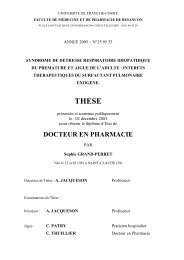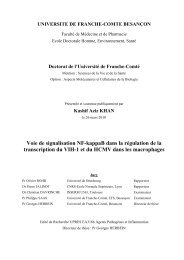THÈSE - Université de Franche-Comté
THÈSE - Université de Franche-Comté
THÈSE - Université de Franche-Comté
You also want an ePaper? Increase the reach of your titles
YUMPU automatically turns print PDFs into web optimized ePapers that Google loves.
over a relatively long-term (four years) period. In<strong>de</strong>ed, Jacob et al., observed a direct negative<br />
impact of the mowing by assessing the number of voles one month prior to and after mowing.<br />
In<strong>de</strong>ed, mowing can generate temporary disturbances for voles (disturbance and mortality by<br />
farming machinery, <strong>de</strong>crease of plant shelter and food supply) (Jacob 2003). However, the<br />
high reproductive potential of the vole species enables populations to recover to pre-mowing<br />
levels rapidly (Taitt & Krebs 1983; Edge, Wolff & Carey 1995). Furthermore, some authors<br />
suggested that voles may relocate from disturbed areas to adjacent non-crop refuge (hedges,<br />
tree rows, road verges, fence lines) (Rogers & Gorman 1995). In our study area, farmers<br />
provi<strong>de</strong> forage to cattle during winter months (October to March) and thus store hay. As a<br />
result, they use grassland fertilisation to increase hay production. The number of annual<br />
cuttings was positively correlated with the annual forage yield, which was also positively<br />
correlated with organic nitrogen fertilisation (Fig. 3). In the latter case mowing could be an<br />
indicator of higher grass production, and, thus, the real cause of vole higher relative<br />
population abundance. Specifically, our study also revealed a significant positive correlation<br />
between the amount of organic nitrogen fertiliser used annually and the early increase in A.<br />
terrestris population in the parcels. On the one hand, this result could be explained by the<br />
favourable effect of organic nitrogen on primary production, which could provi<strong>de</strong> a better food<br />
supply and shelter from predators to the vole population. Furthermore, repeated mowing is<br />
favourable to plant biodiversity as it increases nutrient cycling (Fedoroff et al. 2005). On the<br />
other hand, this result suggests some indirect positive effect of organic nitrogen on A.<br />
terrestris relative abundance via T. europaea relative abundance during the low <strong>de</strong>nsity phase<br />
of A. terrestris. In<strong>de</strong>ed, higher organic fertilisation increases the abundance of earthworms<br />
(Lopez-Hernan<strong>de</strong>z et al. 2004), the principal food source for T. europaea (Edwards et al.<br />
1999). Our results reflected the influence of T. europaea. These results are in agreement with<br />
those of Delattre et al. (submitted), who found a significant positive correlation between T.<br />
europaea relative abundance during A. terrestris low <strong>de</strong>nsity phase and the abundance level<br />
reached by A. terrestris populations during the increase phase.<br />
THE HIGH DENSITY PHASE OF THE A. TERRESTRIS POPULATION CYCLE<br />
In this study, we showed that A. terrestris relative abundance <strong>de</strong>clined with increasing<br />
intensity of grazing (Fig. 5a) or soil work (Fig. 5b). These two specific farming practices may<br />
have similar consequences on population dynamics. The mere presence of cattle may affect<br />
Thèse C. Morilhat 2005 107









